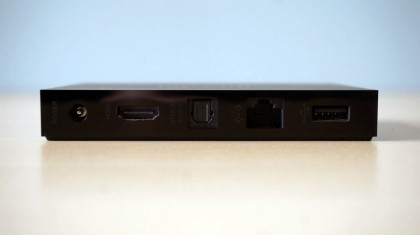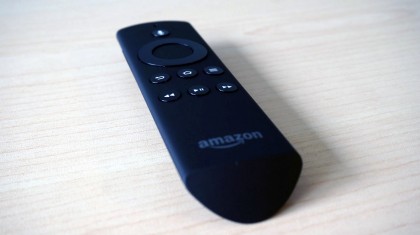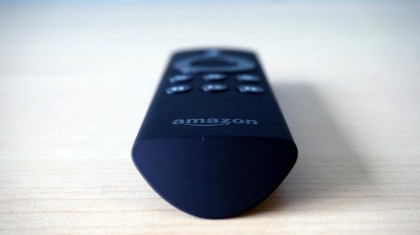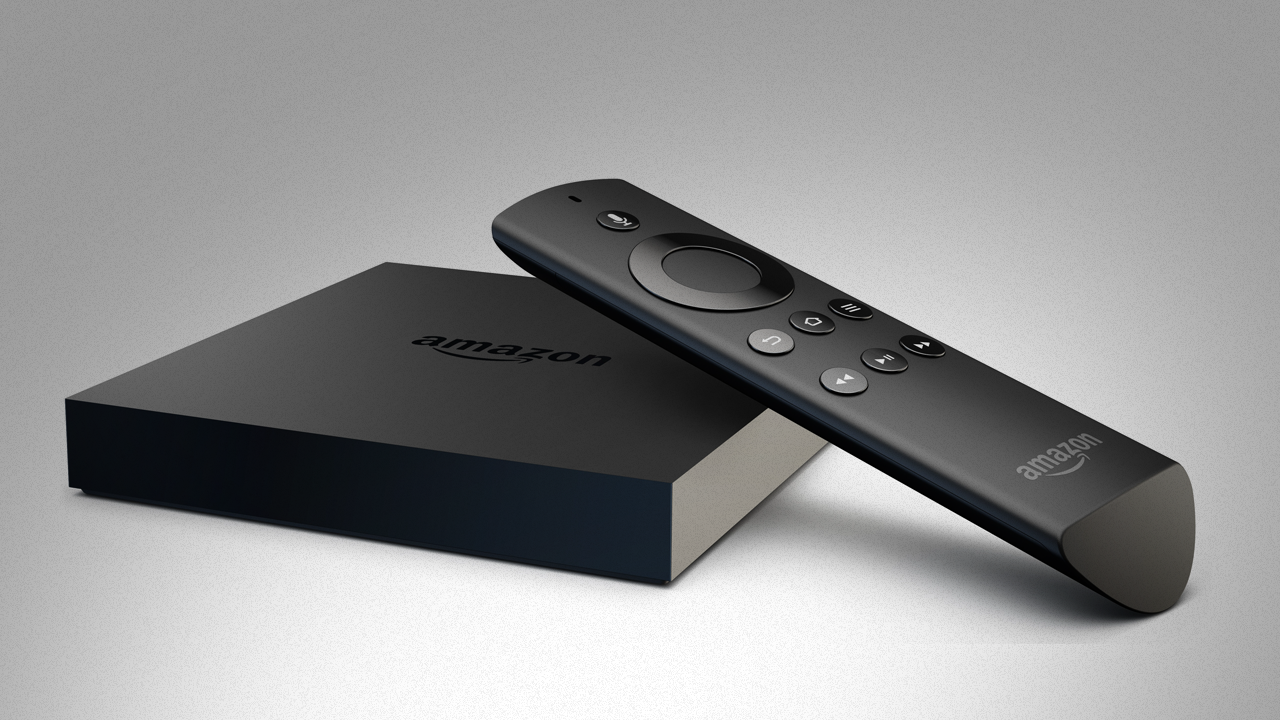Why you can trust TechRadar
Hardware and design
The box itself is about the size of a small external hard drive, or two CD jewel cases stacked on top of one another. Think of a tiny, squared-off version of the monolith from 2001: A Space Odyssey lying flat.
Its exterior is sleek and minimalist, with the only contrast coming from glossy black lettering on a matte black background. At 0.7 inches thick, all of its visual cues seem to be telling you, "Don't see me." Its rear side is devoted to the essential ports: power, HDMI, optical audio, Ethernet and USB.

Under the hood, Fire TV is quite powerful compared to its competitors, sporting a quad-core processor, a discrete GPU and 2GB of RAM.
Amazon claims it has three times the processing power of Apple TV, Chromecast or Roku 3, and says it can process 57 billion floating point operations per second. You can wire it into your router via Ethernet, but if that's inconvenient, Fire TV also packs two dual-band Wi-Fi antennas.
All of this adds up to notably snappy menu performance. Movie titles fly by in the interface, transitioning between services is fast and the system handles itself impressively when tasked with rendering games.
The Fire TV's minimalist matte black remote is similar in functionality to Roku's, with seven glossy black buttons and a directional selector. It uses Bluetooth to communicate, eliminating line-of sight issues and allowing you to stash the box inside a cabinet or behind a TV.
There are buttons for back, home, menu, rewind play/pause and fast forward. Topping the remote on its own is the microphone button that may one day be Fire TV's secret weapon (but not now, for more on this see the Interface and Search section).

Setup
As with Roku 3 and Apple TV, Fire TV's setup is eerily simple, and consists of connecting two or three wires (power, HDMI and an optional ethernet cable). If you don't have it wired to your router, the system will walk you through forging a WiFi connection.
As with the Kindle Fire, when you order a Fire TV, Amazon pre-links it to your Amazon account, so after a quick (unskippable) tutorial video you're immediately able to browse Amazon Instant and Amazon Prime videos along with any photos in your cloud drive.
Third party apps must be downloaded and set up separately with their own credentials. In terms of simplicity, the setup process is a win, but its lack of customization options leaves you at the mercy of the one-size-fits-all menu hierarchy Amazon has created (more on this later).
Movies games and videos

Naturally, the system provides full-spectrum access to Amazon's cloud video services, and Amazon Instant and Amazon Prime Video are both well (if not over) represented.
At launch, Fire TV offered 40 third-party channels, a far cry from the hundreds available on Roku and Chromecast, but more deals are likely in the works.
Amazon did make sure they had the most significant services coming out of the gate, including Netflix, BBC iPlayer, Amazon Instant Video (obvs!), Plex, Demand 5 and Sky News.
Amazon is touting Fire TV's innards as a competitive advantage in terms of movie performance, but while menus move quickly, our tests didn't uncover much difference in terms of speed to open third party apps or start playing videos as compared with Roku 3 or AppleTV.
Amazon's native offerings, on the other hand, clearly get a boost from living on their home hardware. First off, all of Amazon's content is accessible from the main menu of the system's OS and can start playing without first launching an app.
Secondly, Amazon is introducing a feature called ASAP, which is designed to pre-cache video content for you based on your habits and preferences.
Impressively, playback begins instantaneously when I click, with no load time or buffering. Supposedly the system will make more inferences over time as it monitors my actions.
It's a smart, effective system, but as only Amazon's offerings can use it, it's one more way the playing field inside Fire TV is tilted to the home team's advantage.
Music
Music is available from Amazon's own MP3 store but it's the inclusion of a Spotify app that's likely to appeal to most people. There's also a Ministry of Sound Radio app for music, tunein radio and a few more.
Amazon's Music channel allows you to play songs purchased from Amazon's MP3 store or stored in Cloud Drive.
The photo channel provides a way to access any photos or videos you have stored in Amazon Cloud Drive. Amazon provides a free 5GB of storage for all accounts, and more can be purchased via subscription.
The system works simply and seamlessly. You can upload photos from your computer, or use Amazon's iOS or Android apps to automatically put any photos you take up on the cloud. In addition to letting you page through slide shows, Fire TV can be set to use your images as a screensaver when the system is idle.
James was part of the TechRadar editorial team for eight years up until 2015 and now works in a senior position for TR's parent company Future. An experienced Content Director with a demonstrated history of working in the media production industry. Skilled in Search Engine Optimization (SEO), E-commerce Optimization, Journalism, Digital Marketing, and Social Media. James can do it all.

